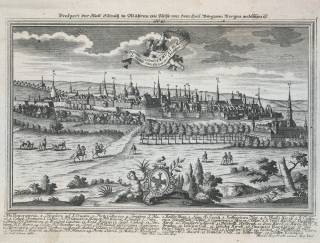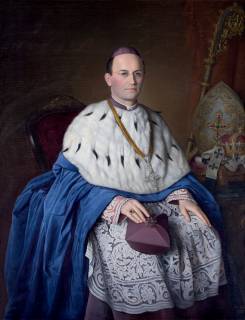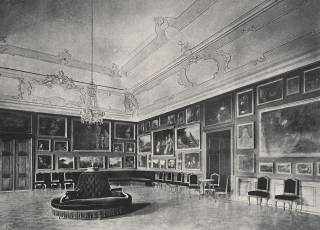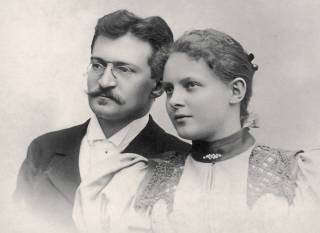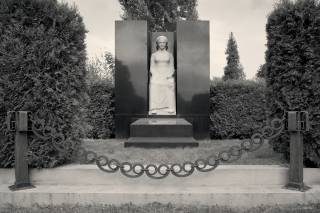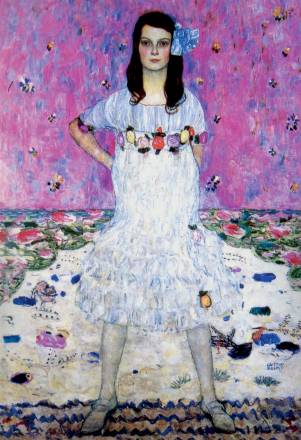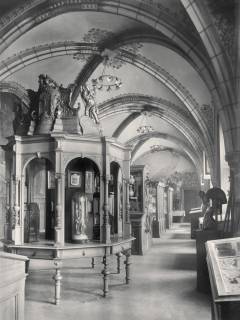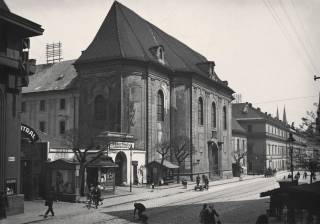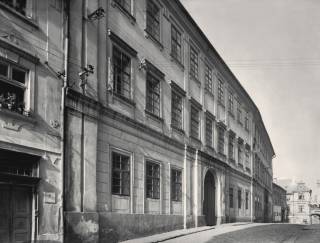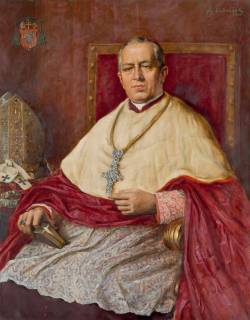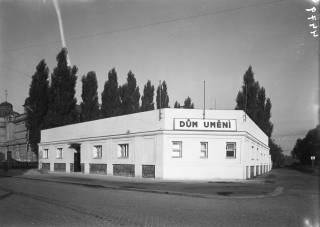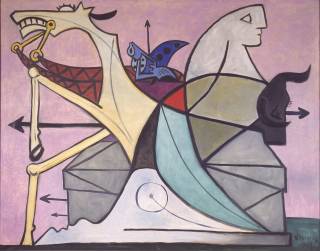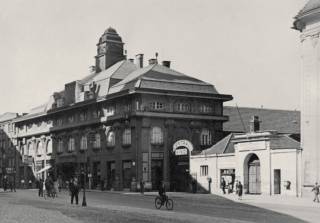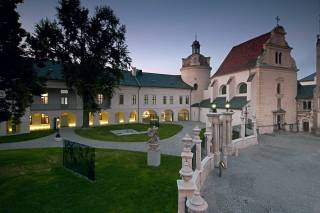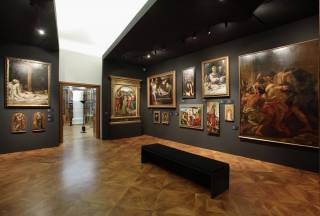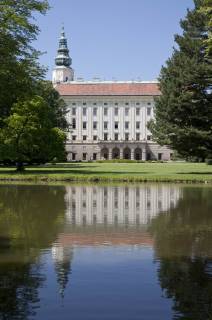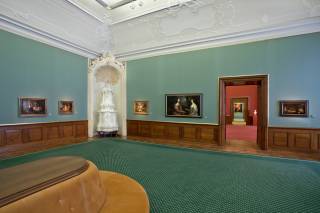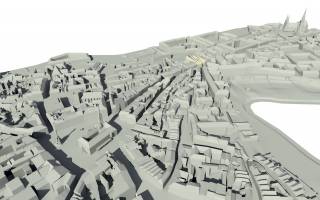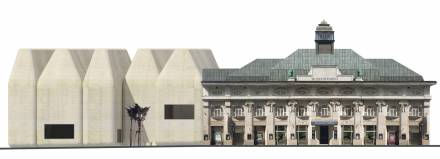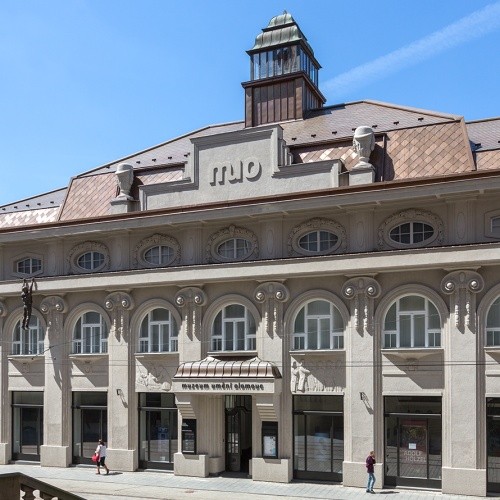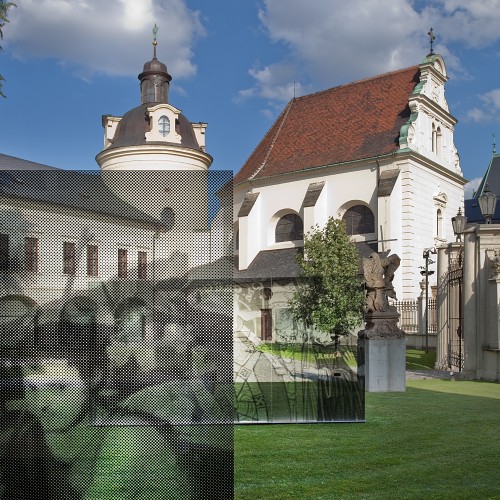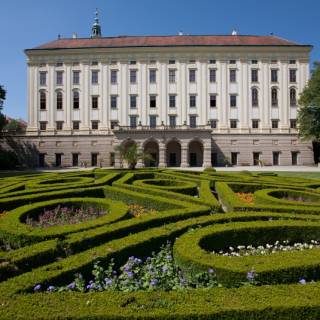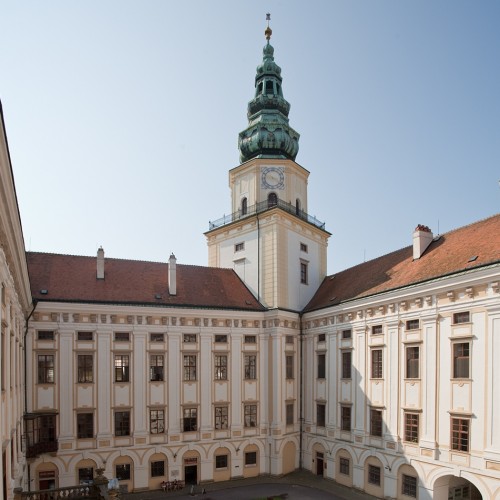History
About the Museum of Art, about collecting and exhibiting fine art in the Olomouc region
Pavel Zatloukal
Olomouc Museum of Art was founded in 1951. Still it cannot be said to have originated through a single, unambiguous act. Its development was gradual with many peripeteias. This holds in particular for its very substance, the state-owned, ecclesiastic and private collections of which it takes care now. Their origin, their local concentration but also dispersion, go back into a rather distant past. Let me remind you briefly of its story.
The royal town of Olomouc lost, due to the Thirty Years’ War, the status of the capital of Moravia but as the seat of the Moravian bishopric and of the university it remained a spiritual center of the country. Its visual culture developed over the next centuries in two parallel streams. The first one was associated with the bishopric and ecclesiastic institutions, the other one was the product of the town dwellers.
Although the beginnings of collecting art in Olomouc may be traced back to the early 16th century, the time when a major centre of Transalpine Renaissance and humanism arose here, the real foundations of collecting are only linked with the episcopate of Karl von Lichtenstein-Castelkorno (1624/1664–1695). The goals of the Bishop’s grand programme were conclusion of the country’s return to the Catholic faith and materiál reconstruction of the country ravished by the long war, as well as the “resurrection of art”. His activities were both versatile and well thought-out. He launched many ambitious building projects so that during his episcopate residential palaces and chateaus were thoroughly rebuilt or newly built, especially in Olomouc, Brno, and the Bishop’s patrimonial town of Kroměříž. In Kroměříž, moreover, he built according to an ingenious iconographic programme, the Chateau grounds with the Chateau Garden and the Floral Garden, with a gallery of statues inspired by Antiquity to decorate the colonnade. The Antiquity and in particular the inspiration by Ovid’s Metamorphoses, that is the theme of Time as the chief agent of change, became literally an idée fixe for the Bishop. He began to invite to Olomouc and Kroměříž many artists, notably from the north of Italy, in order to implement his ambitious artistic aspirations.
In 1673 he entered the ranks of the greatest European art collectors when he acquired a collection of more than two hundred paintings and drawings. It was offered to him by two art dealers, the brothers Franz (1632–1694) and Bernhard (1637–1694) von Imstenraed from Cologne. One part of these paintings of supreme quality came from the collection of the executed English king, Charles I (1600/1625–1649) and other noblemen, such as one of the greatest collectors of his day, Thomas Howard of Arundel (1585–1646). Prevailing in their collection were paintings by notable Italian and Netherlandish Renaissance artists as well as contemporary painters, for instance Hans von Aachen, Jacopo Bassano, Peter Brueghel Sr., Caravaggio, Correggio, Anthonis van Dyck, Lucas van Leyden, Andrea Mantegna, Sebastiano del Piombo, Titian, Palma il Vecchio and Paolo Veronese. The Bishop thus could make a major contribution to his recently founded picture galleries in Olomouc and Kroměříž. Moreover, he continued collecting paintings until the end of his life so that finally the alls of his Moravian residences and their galleries were decorated with some fifteen hundred works of art. Besides, in the Kroměříž Chateau a library was established where he tried to assemble the maximum of contemporary knowledge. He also founded a music collection and a print collection. In 1691 he bequeathed all these collections to his successors, entrusting them with the care and extension of these treasures.
The Bishop’s interest in art inspired other patrons and art collectors. Collecting developed favourably in Olomouc until the middle of the 19th century. Large collections of paintings, drawings and prints, in this country showing preference for Italian, Netherlandish and Central European art, were amassed by some Canons, members of the Olomouc chapter, as well as by monastic orders, especially the Olomouc Augustinians and the Premonstratensians from the nearby Hradisko monastery and its priory at Svatý Kopeček.
While the Olomouc Baroque in the 17th century was largely the work of non-local artists, coming from Italy, Austria or Germany, in the first half of the 18th century it was developed mainly by local artists. In spite of many natural disasters suffered by the town after 1700, these artists transformed its main parts into a remarkable public glyptotheque, which became a pendant to the local picture galleries. A set of fountains inspired by ancient mythology was built and the main square became dominated by a Central European Baroque monument, the honorary Holy Trinity Column. The citizens of Olomouc in those days saw themselves as inheritors of ancient Rome (according to a humanist legend, the town was founded by Gaius Iulius Caesar) and as descendants of the men who had rescued Christianity (beneath the town walls of Olomouc, another legend said, the Asian raiders had been stopped five centuries before).
This legendary flowering died with the transformation of Olomouc into a strong border fortress. Due to the subsequent Enlightenment reforms and the abolition of convents and monasteries, the town lost most of its art collections and as well as its rich library. Also, the Bishops and since 1777 Archbishops of Olomouc in their building and collecting activities began to turn to the nearby Kroměříž, preferring its Chateau and gardens. Archbishop Anton Theodor Colloredo-Waldsee (1726/1777–1811) finished the protracted restoration of the Chateau damaged by a devastating fire, and when reorganizing the Chateau gallery he had many paintings from the Lichtenstein collection moved from Olomouc to Kroměříž. Besides, he was very much concerned with the Chateau Garden, converting it into a jardin pittoresque. The Olomouc picture gallery, however, fell into decline and found itself almost on the brim of extinction when in 1830, during the episcopate of Archbishop Rudolph Johann (1788/1819–1831), more than two hundred paintings, allegedly unnecessary, were sold in auction; among them was a large part of the Imstenraed collection. A similar auction, though with smaller losses, was held in Kroměříž.
Things took a turn for the better under Archbishops Friedrich von Fürstenberg (1813/1853–1892) and Theodor Kohn (1845/1893–1904/1915). Purchases were resumed, especially of Old Italian art, in order to expand the Olomouc picture gallery. The Chateau Gallery in Kroměříž was re-arranged and scores of old paintings were restored. The last Archbishop of Olomouc with cultural and collecting ambitions was Leopold Prečan (1866/1923–1947) but due to the tragic developments in Central Europe he had no successors in collecting. He continued in the restoration of many paintings in Kroměříž and virtually brought back to life the collection in the Olomouc residence after adding many new acquisitions to it.
But let us turn back for a while to the 19th century. At its end, the Olomouc fortress was abolished and around 1900 the town enjoyed a short era of building activity (Gründerzeit). The 19th century was a century of historicism and of foundation of museums. Several of them came into existence in Olomouc. After the model of London and Vienna, the Kaiser Franz Josef Gewerbe-Museum was established in 1873, Historisches Museum der Stadt Olmütz was born in 1879, in 1883 the Vlastenecký spolek musejní v Olomouci (Patriotic Museum Association in Olomouc) was founded, and finally in 1908 the Herzog Josef Ferdinand-Museum was opened.
In these museums were concentrated the previously scattered public collections and several private collections of old art and since then they have been more or less systematically extended with acquisitions of contemporary art. In 1900 Gesellschaft der Kunstfreunde in Olmütz (The Society of Friends of Art in Olomouc) was founded and began to organize regular exhibitions. In those days in the whole of Europe it was art associations or societies of friends of art who were the main protagonists of exhibitions and of the art market. Already at the opening exhibition of the Society of Friends of Art, several hundred works from local public and private collections were displayed. The next exhibitions, mostly held at regular intervals, were devoted to the work of artists from Olomouc and Moravia, both Czechs and Germans from Olomouc but also to individual painters and graphic artists and art societies from Vienna, Austria and Germany.
In this milieu lived the industrialist and banker Otto Primavesi (1868–1926) and his wife Eugenia (Mäda, 1874–1962). In the last decade before the First World War they became foremost Central European supporters and collectors of art. In their new „English“ house in the centre of Olomouc they amassed remarkable collections of leading representatives of the Viennese Jugendstil and Symbolism. They commissioned sculptures from Anton Hanak (1875–1934), paintings from Gustav Klimt (1862–1918). In their collections they aimed at capturing the symbolist idea of the cult of woman, womanhood, motherhood, childhood and regeneration of life coming from it, in the wide range from woman – child through woman up to femme fatale. Moreover, they made a great effort at achieving unity of the style and of the ideal of the Gesamtkunstwerk – coordination of architecture, free and applied art – and, last but not least, the unity of life and art. Let us remember Hanak’s fountain Das Kind über dem Alltag (The Child above the everyday) or Klimt’s Portrait of Mäda Jr. Their endeavours culminated in the cooperation with another friend of the family, architect Josef Hoffmann (1870–1956). He designed for them a large summer residence in Kouty nad Desnou, the rooms completely furnished by the arts-and-crafts workshops Wiener Werkstätte. In those days the married couple in Olomouc became intensively committed in the Viennese workshops and finally took over their management. After the war they devoted all their energy and money to this remarkable attempt at the creation of a complex life style but in the changed social situation were unable to prevent the bankruptcy of the workshops. Their outstanding collections were then scattered all over the world, in Olomouc only a torso of Hanak’s statues remained.
In the interwar years, too, art exhibiting in Olomouc was mostly in the hands of art societies. Klub přátel umění (The Club of Friends of Art) and later also the Skupina olomouckých výtvarníků (Group of Olomouc Artists) brought together Czech artists. The local Germans and Jews continued holding their exhibitions under the Gesellschaft der Kunstfreunde in Olmütz and the newly founded branch of the national association Metznerbund – naturally only up to the occupation of Czechoslovakia in 1939. The tragedy of the holocaust affected the collecting in Olomouc, and several major art collections of European art disappeared from the town.
After the Second World War, the museums in Olomouc underwent significant changes. As early as 1924, the three Olomouc museums were merged into a single Museum hlavního města Olomouce (Museum of the Capital City of Olomouc). The sphere of competence of the new (since 1951 Vlastivědné muzeum Olomouc – Regional Museum Olomouc) was the whole region, and within its framework Galerie výtvarného umění (Gallery of Art) was founded in Olomouc. Its collections increased during the whole first half of the 1950s, being made up from collections of the Museum of the Capital City of Olomouc, from works confiscated from the Germans expelled from Olomouc, from some nationalized ecclesiastic property, and from the collections of art societies in Olomouc – The Club of Friends of Art and the Group of Olomouc Artists. The first exhibitions and permanent exhibitions took place in the Regional Museum, but the gallery soon acquired the building of the House of Art and many years later the small Kabinet grafiky (Cabinet of Graphic Art). In 1954 the first permanent exhibition of Czech visual art of the 20th century was opened and in later years was several times reorganized. It was complemented by a permanent exhibition of 19th century painting at the nearby chateau Náměšť na Hané.
The exhibition of modern art was initially based on loans from the National Gallery in Prague (such was already the interwar tradition) but later the Gallery could already depend on its own collections. They grew through purchases, bequests and gifts and during the 1960s made the Olomouc Gallery the third largest public collection of art in the country. At that time the Gallery became orientated, besides local and Czech art, towards foreign art, with specialization in 20th century sculpture. Another specialized collection was that of small and applied graphic art (ex libris). In 1967, from the archbishopric’s collection and from the Old Art collection in the Gallery, an exhibition named Masterpieces of Old Art in Olomouc was opened, which after decades of absence of interest put on display select works of art from the collection of Bishop Karl von Lichtenstein-Castelkorno.
This promising development was interrupted by the occupation of Czechoslovakia by the armies of the Warsaw Pact in 1968. New purchases as well as exhibiting of art were heavily restricted by the demolition of the House of Art (1980). Permanent displays were reduced to the Memorial Hall of three local artists. In the period of “normalization” the isolation based on ideology and nationality could only be broken in a few minor spheres, such as new acquisitions of drawings and prints, and establishing a collection specialized in architecture. Real living art, however, could not reach the exhibition rooms and could be shown – though with difficulty – elsewhere only in the so called grey zone. With a few exceptions, not even old art could be exhibited in those days.
This wretched time ended with November 1989. The Gallery obtained a large building in the historical centre of the town. During the 1990s the rooms were converted to multiple use – exhibitions, lectures, educational courses, library, café, depositories, and staff offices. With the opening of the first exhibition rooms in 1993 the Gallery changed its name to Muzeum umění Olomouc (Olomouc Museum of Art). This change was to separate the old-new institution from the quickly developing commercial sphere but especially to indicate a new orientation towards a wider conception of visual culture. Its activities gradually spread from art in the Olomouc Region to Czech art and finally to international art. Among the new acquisitions were the previously proscribed artists and entire thematic circles. Also, collecting now began to include photography, applied art (seating furniture), and artist’s books. Publishing activities began to flourish. And almost every day, besides exhibitions there is an evening programme: a lecture, a talk with a discussion, a concert, an animation activity.
After an agreement with the Olomouc archbishopric and the Ministry of Culture of the Czech Republic, the Museum of Art was entrusted with establishing the Arcidiecézní muzeum Olomouc (Olomouc Archdiocesan Museum) – the first specialized museum of this kind in the country. The final stimulus was given by the visit of Pope John Paul II in Olomouc in 1995, when he encouraged the Catholic Church several times to become committed in cultural activities, like in the old days. For the seat of the Archdiocesan Museum was chosen one part of the old Olomouc castle situated next to St Wenceslas Cathedral. The Church made available the chapter deanery and the complex of the Romanesque palace as well as a substantial part of its own art collection, while the state pledged, through the Museum, to pay for the restoration of the buildings and the maintenance of the new museum. After a demanding reconstruction combined with a large-scale archaelogical survey and restoration work, the new museum was opened in 2006. In addition to one part of the Bishop’s Romanesque palace dating back to the middle of the 12th century, with Gothic cloisters surrounding the cloister garth, and with its medieval, Renaissance and Baroque space, visitors now can also walk in the underground archeological zone with several permanent exhibitions, a collection of Gothic art, and an Olomouc Gallery collection. The latter is a selection from three traditional collections of paintings – from the archbishopric, the Museum, and one private owner. Besides, the Museum contains rooms for short-term exhibitions, a multi-purpose hall named Mozarteum (in honour of Mozart’s family staying here), classrooms, café, while in the former husbandry yard are situated depositories, the restorer’s studio, and staff offices.
One year later (2007), another Archdiocesan Museum was opened, at the Chateau in Kroměříž (Arcidiecézní muzeum Kroměříž – Kroměříž Archdiocesan Museum). Olomouc archbishopric entrusted Olomouc Museum of Art with professional administration of a large collection (over 100,000 items), including works of painting, sculpture and graphic art, coins and medals, applied art as well as an archive of music and the library. In addition to the picture gallery, the Museum offers rooms for short-term exhibitions. The Museum of Art also participates in the theoretical part of the project National Centre of Garden Culture, designed for methodical reconstruction of the Early Baroque Floral Garden and part of the romantic Chateau Garden. There is to be developed here a centre for teaching restoration work and subsequent care of historical gardens and parks, including a permanent exhibition of garden culture.
Since their foundation, the two Archdiocesan Museums have intensive exhibiting and publishing activities to their credit. Earlier, the collection of old paintings and the three circles of the Olomouc gallery had received professional treatment. One of the culminations in the care of old art was the exhibition The Last Flowers of the Middle Ages – From Gothic to the Renaissance in Moravia and Silesia, held in conclusion of the jubilee year 2000 in Palazzo Venezia in Rome. The cycle of catalogues of the exhibitions of restoration work received awards in the Europa Nostra contest. There were, however, other kinds of exhibitions too – some of them dealing with Moravian Baroque and its artists, others showing noted foreign collections of old and modern art with spiritual orientation.
So far the Museum’s last great project was the Středoevropské forum Olomouc (Olomouc Central European Forum). The preparations for it go back to 2007. A new building to be situated next to the Museum, on the empty space created by the demolition of five period houses, is to contain exhibition halls, a large library and archive, and rooms for active contact with the museum-goers. Simultaneously the reconstruction of the Muzeum moderního umění (Museum of Modern Art, as the main museum building is now called) should be finished. Part of the Forum should be the small Theatre of Music, active in the building since 1968, integrated into the structure of the Museum of Art in 2014, and the interwar Central cinema. The Forum thus should unite in its grounds almost all artistic genres. Its major objective is to be the registering of the wide variety of cultural events in Central Europe, the development of a permanent exhibition of visual arts since the Second World War, new acquisitions, holding short-term exhibitions including bienales or trienales of postwar and contemporary art, the establishing of an information centre, a library with a multimédia archive, etc. The project is based on several ideas: Central Europe was in its history and is now a region sharing many similar, sometimes even identical features. And yet, this has never been systematically studied, compared and published. Not to speak of the fact that the ideas did not flow in one direction only, from the West to Central Europe and further to the East. Much of what was going on after the Second World war in the West was paralleled by relatively independent equivalents here, in Central and Eastern Europe. Central Europe, however, is also comprised of millions of refugees and exiles living all over the world. Besides the Czech lands and Slovakia, our objects of interest are Hungary, Poland, but also the other side of the Iron Curtain – Austria and a greater part of Germany. The principal goal of the project thus is a complex integration of the national cultures in a wider, Central European context because, frankly, they arose in this framework.
In this connection the Museum has for years been dealing with arts in Slovakia, Hungary, Poland, occasionally also in Germany and Austria, and exhibiting them or acquiring works of foremost artists from these countries; each year, for instance, one exhibition is devoted to the Forum, be it the new acquisitions or the architectural design of the new building. Unfortunately, the grant aid (under the project of European assistance to regions) is still unavailable; preparátory work is proceeding notwithstanding.
Olomouc Museum of Art currently maintains about 180,000 collection items, from old as well as modern art. Its activities take place in three buildings – the Museum of Modern Art (the future Olomouc Central European Forum) and in two archdiocesan museums, in Olomouc and Kroměříž. Its objectives are, besides offering aesthetic experience and instruction, a rehabilitation of the former position of Olomouc. By confrontation of old and modern art it helps to maintain continuity between the contemporary period and the fundamental pillars of European civilization – antiquity, judaism, and Christianity.
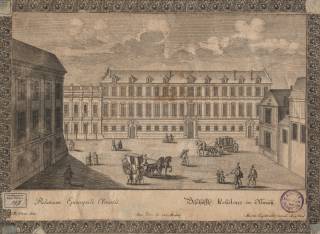
Martin Engelbrecht after Friedrich Bernhard Werner, Bishop’s Palace in Olomouc, around 1740
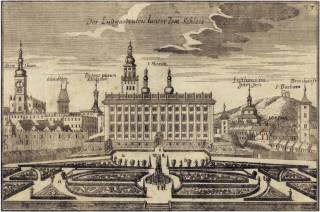
Justus van den Nypoort after Georg Matthias Vischer, Chateau with Chateau Garden in Kroměříž, 1691
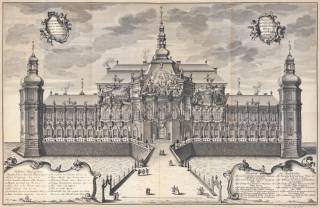
Martin Engelbrecht after Friedrich Bernhard Werner, Hradisko Monastery, around 1740

František Vavřinec Korompay – circle, Arrival of Cardinal Troyer in Olomouc – detail, 1783
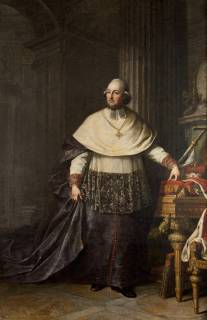
Josef Hickel, Cardinal Anton Theodor Colloredo-Waldsee, 1778
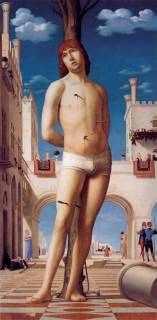
Antonello da Messina, St Sebastian, (1475–1476), sold by auction in 1830, Dresden, Gemäldegalerie Alter Meister
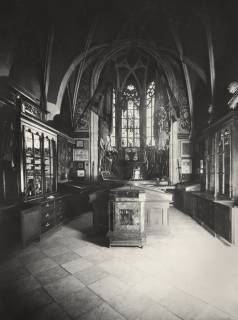
From the permanent exhibition of the Municipal Archive and the History Museum of Olomouc in st Hieronymus Chapel in the Town Hall, SOkAO
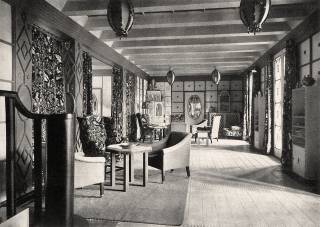
Entrance hall in the Primavesi summer home at Winkelsdorf (Kouty nad Desnou), 1913–1915
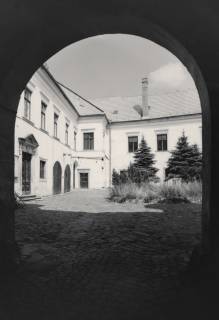
Memorial Halls of Bohumír Dvorský, Vladimír Navrátil and Karel Svolinský – courtyard of the canon’s residence, 1990


